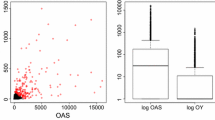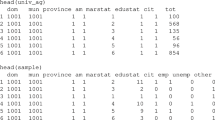Abstract
Small area estimation with categorical outcomes often requires intensive computation, as the marginal likelihood does not have a closed form in general. The likelihood analysis is further complicated by deviations in distributional assumptions often arise through outliers in the data. In this paper, the author proposes a robust method for estimating the small area parameters. Finite-sample properties of the estimators are investigated using Monte Carlo simulations. The empirical study shows that the proposed robust method is very useful for bounding the influence of outliers on the small area estimators. To approximate the mean squared errors of the estimators, a parametric bootstrap method is adopted. An application is also provided using actual data from a public health survey.







Similar content being viewed by others
References
Battese, G.E., Harter, R.M., Fuller, W.A.: An error-components model for prediction of county crop areas using survey and satellite data. J. Am. Stat. Assoc. 83, 28–36 (1988)
Cantoni, E., Ronchetti, E.: Robust inference for generalized linear models. J. Am. Stat. Assoc. 96, 1022–1030 (2001)
Chambers, R.L., Tzavidis, N.: M-quantile models for small area estimation. Biometrika 93, 255–268 (2006)
Datta, G.S., Rao, J.N.K., Smith, D.D.: On measuring the variability of small area estimators under a basic area level model. Biometrika 92, 183–196 (2005)
Franco, C., Bell, W.R.: Borrowing information over time in binomial/logit normal models for small area estimation. Joint Issue Stat. Transit. Survey Methodol. 16, 563–584 (2015)
Ghosh, M., Lahiri, P.: A hierarchical Bayes approach to small area estimation with auxiliary information (with discussion). Bayesian Analysis in Statistics and Econometrics, pp. 107–125. Springer, Berlin (1992)
Ghosh, M., Natarajan, K., Stroud, T.W.F., Carlin, B.P.: Generalized linear models for small-area estimation. J. Am. Stat. Assoc. 93, 273–282 (1998)
Hall, P., Maiti, T.: On parametric bootstrap methods for small area prediction. J. Roy. Stat. Soc. B 68, 221–238 (2006)
Jiang, J., Lahiri, P.: Empirical best prediction for small area inference with binary data. Ann. Inst. Stat. Math. 53, 217–243 (2001)
Jiang, J., Lahiri, P.: Mixed model prediction and small area estimation. Test 15, 1–96 (2006)
Jiang, J., Lahiri, P., Wan, S.-M.: A unified jackknife theory for empirical best prediction with M-estimation. Ann. Stat. 30, 1782–1810 (2002)
Maiti, T.: Robust generalized linear mixed models for small area estimation. J. Stat. Plan. Inf. 98, 225–238 (2001)
Malec, D., Sedransk, J., Moriarity, C.L., LeClere, F.B.: Small area inference for binary variables in the national health interview survey. J. Am. Stat. Assoc. 92, 815–826 (1997)
McCulloch, C.E.: Maximum likelihood algorithms for generalized linear mixed models. J. Am. Stat. Assoc. 92, 162–170 (1997)
Prasad, N.G.N., Rao, J.N.K.: The estimation of the mean squared error of small area estimators. J. Am. Stat. Assoc. 85, 163–171 (1990)
Preisser, J.S., Qaqish, B.F.: Robust regression to clustered data with application to binary responses. Biometrics 55, 574–579 (1999)
Rao, J.N.K.: Small area estimation. Wiley, New Jersey (2003)
Rao, J.N.K.: Interplay between sample survey theory and practice: an appraisal. Survey Methodol. 31, 117–138 (2005)
Rao, J.N.K., Sinha, S.K., Dumitrescu, L.: Robust small area estimation under semi-parametric mixed models. Can. J. Stat. 42, 126–141 (2014)
Rousseeuw, P.J., van Zomeren, B.C.: Unmasking multivariate outliers and leverage points. J. Am. Stat. Assoc. 85, 633–639 (1990)
Salibian-Barrera, M., Van Aelst, S.: Robust model selection using fast and robust bootstrap. Comput. Stat. Data Anal. 52, 5121–5135 (2008)
Sinha, S.K.: Robust analysis of generalized linear mixed models. J. Am. Stat. Assoc. 99, 451–460 (2004)
Sinha, S.K., Rao, J.N.K.: Robust small area estimation. Can. J. Stat. 37, 381–399 (2009)
Torabi, M., Shokoohi, F.: Non-parametric generalized linear mixed models in small area estimation. Can. J. Stat. 43, 82–96 (2015)
Tzavidis, N., Ranalli, M.G., Salvati, N., Dreassi, E., Chambers, R.L.: Robust small area prediction for counts. Stat. Methods Med. Res. 24, 373–395 (2015)
Acknowledgements
This research was partially supported by a Grant from the Natural Sciences and Engineering Research Council (NSERC Grant no. RGPIN-2016-06258) of Canada.
Author information
Authors and Affiliations
Corresponding author
Additional information
Publisher's Note
Springer Nature remains neutral with regard to jurisdictional claims in published maps and institutional affiliations.
Appendix
Appendix
1.1 A1: Variance of the RML Estimator
The variance-covariance matrix of the robust estimators \(\hat{\varvec{\gamma }} = ({\hat{\beta }}, {\hat{\sigma }}_u)^t\) in Sect. 4 may be approximated by
where \({\mathbf {M}}_k (\varvec{\gamma })\) and \({\mathbf {Q}}_k (\varvec{\gamma })\) may be partitioned as
and
with components
with \(g_{ij} (\varvec{\gamma }, y_{ij}, {v}_i) = y_{ij} - \mu _{ij} (\varvec{\gamma }, {v}_i)\), and
Also, we have \({Q}_{\sigma \beta } = {Q}_{\beta \sigma }^t\).
1.2 A2: Predicted area means and root MSPEs for CCHS data
See Table 6.
Rights and permissions
About this article
Cite this article
Sinha, S.K. Robust small area estimation in generalized linear mixed models. METRON 77, 201–225 (2019). https://doi.org/10.1007/s40300-019-00161-6
Received:
Accepted:
Published:
Issue Date:
DOI: https://doi.org/10.1007/s40300-019-00161-6




